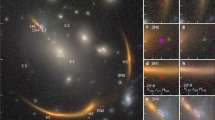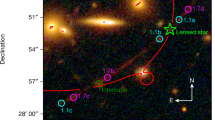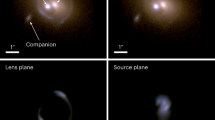Abstract
A predicted consequence of cosmic strings is that they should produce equal-brightness double-lens images of distant quasars (QSOs), with separations of up to several minutes of arc (see refs 1, 2). Here I discuss a newly discovered lens candidate3–6: QSO1146+111B,C which appears to consist of two images of equal brightness (B is 1.02 times as bright as C, with virtually identical spectra over the observed range) of a quasar at redshift z = 1.01, which are separated by 2.6 arc min. If this is produced by a cosmic string, its mass per unit length is µ⩾4.0×1023 g cm−1, a value large enough to be interesting for string-assisted galaxy formation7–9 and near the upper limits implied by the isotropy of the cosmic microwave background2,10 and constraints on gravitational radiation11. But note that four other QSOs, also close enough to be double-imaged, have thus far not been detected. Searches for these and for the microwave background temperature shift across the string2,10 would be useful.
This is a preview of subscription content, access via your institution
Access options
Subscribe to this journal
Receive 51 print issues and online access
$199.00 per year
only $3.90 per issue
Buy this article
- Purchase on Springer Link
- Instant access to full article PDF
Prices may be subject to local taxes which are calculated during checkout
Similar content being viewed by others
References
Vilenkin, A. Phys. Rev. D23, 852–857 (1981).
Gott, J. R. Astrophys. J. 288, 422–427 (1985).
Hazard, C., Arp, H. & Morton, D. C. Nature 282, 271–272 (1979).
Arp, H. & Hazard, C. Astrophys. J. 240, 726–736 (1980).
Paczynski, B. Nature 319, 567–568 (1986).
Turner, E. L. et al. Nature 321, 142–144 (1986).
Zeldovich, Ya. B. Mon. Not. R. astr. Soc. 192, 663–667 (1980).
Vilenkin, A. Phys. Rev. Lett. 46, 1169–1172 (1981).
Turok, N. & Schramm, D. N. Nature 312, 598–599 (1985).
Kaiser, N. & Stebbins, A. Nature 310, 391–393 (1984).
Hogan, C. & Rees, M. Nature 311, 109–114 (1984).
Turok, N. Phys. Lett. 123B, 387–390 (1983).
Gott, J. R. & Gunn, J. E. Astrophys. J. Lett 190, L105–L108 (1974).
Turner, E. L., Ostriker, J. P. & Gott, J. R. Astrophys. J. 284, 1–22 (1984).
Author information
Authors and Affiliations
Rights and permissions
About this article
Cite this article
Gott, J. Is QSO1146+111B,C due to lensing by a cosmic string?. Nature 321, 420–421 (1986). https://doi.org/10.1038/321420a0
Received:
Accepted:
Issue Date:
DOI: https://doi.org/10.1038/321420a0
This article is cited by
-
Lensing by exotic objects
General Relativity and Gravitation (2010)
-
Marginal gravitational lenses of large separation: probing superclusters
Nature (1987)
-
Double clusters and gravitational lenses
Nature (1986)
-
Arc minute gravitational lenses and cosmic strings
Nature (1986)
-
Have burnt-out galaxies and galaxy clusters been detected?
Nature (1986)
Comments
By submitting a comment you agree to abide by our Terms and Community Guidelines. If you find something abusive or that does not comply with our terms or guidelines please flag it as inappropriate.



